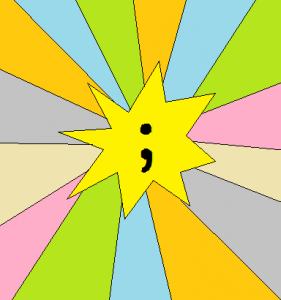Among punctuation marks, the semicolon is the nerdy kid who gets picked on and is chosen last for sports teams. The semicolon goes on to college, of course, and finds steady employment, but never moves up or achieves greatness, and yet falls asleep each night dreaming of a life that might have been.
 As a refresher, the semicolon links major sentence elements together. It can keep two related independent clauses loosely joined; it also separates items in a list, especially when some listed items contain commas.
As a refresher, the semicolon links major sentence elements together. It can keep two related independent clauses loosely joined; it also separates items in a list, especially when some listed items contain commas.
Search on your keyboard and you’ll find the semicolon, perhaps sharing a rarely used button with the colon. Yes, it’s that half-comma and half-period thingy—(;). Take a good look, because it may not appear on future keyboards.
That’s right. The semicolon is falling into disuse. With limited keyboard territory available, that’s a kiss of death. Future generations might well ponder about the meaning of that strange mark, unless nearer term translators simply delete it from all texts, substituting commas or periods (or emojis) as they see fit.
Semicolons have hit on hard times, or Times. Ben Macintyre, a columnist in The Times of London wrote, “Hemingway and Chandler and Stephen King wouldn’t be seen dead in a ditch with a semi-colon…Real men, goes the unwritten rule of American punctuation, don’t use semi-colons.”
The semicolon’s chief detractor, however, had to be Kurt Vonnegut, who said semicolons are “transvestite hermaphrodites representing absolutely nothing. All they do is show you’ve been to college.”
Sheesh. It’s a semicolon, guys. Do you have to drag sex into everything?
Most people don’t hate the semicolon; they either don’t understand it or don’t see the point of it. Scorn from Vonnegut is one thing; at least he paid the semicolon some attention. But to be ignored and forgotten is far worse.
Despite being the shunned wallflower at parties where the comma and period are the hits, the semicolon boasts of a noble history. In The Tempest, Shakespeare has Prospero use one: “We are such stuff as dreams are made on; and our little life is rounded with a sleep.” The Bible is smitten with semicolons, starting in the second phrase of Genesis: “And the earth was without form, and void; and darkness was upon the face of the deep.”
Eight semicolons lend their gravitas to the U.S. Declaration of Independence, and the U.S. Constitution teems with forty-eight of them.
That’s all fine and good, you’re thinking, but tell me what semicolons have done for us lately. And none of that poetry stuff, either. Cite some recent examples of great prose featuring a semicolon.
Sorry, I can’t. It seems that profound prose demands either the finality of a period or the casual linking of a comma. I’ve had anthology editors (bless their persnickety blue pencils) strike some of my semicolons out of existence with their sweeping editorial delete marks. Even so, I use the mark sparingly, varying between two and thirteen times in my last five published stories, for an average of one semicolon in every 54 sentences.
The semicolon enjoys the support of a few writers out there, including Ben Dolnick and Mary Norris, but such praise is rare and scattered. There is no organized ‘Save the Semicolon’ movement, or even a Kickstarter or GoFundMe page.
So, Caring Readers, it’s up to you. Preserving this punctuation mark will depend on how often we all use it. Do your part; my part will be done by—
Poseidon’s Scribe
